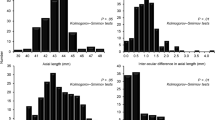Abstract
Purpose
To test the reliability and accuracy of the 2Win Refractometer Corneal Reflexes App (CR App) in detecting manifest strabismus in pediatric patients.
Methods
Prospective study involving 167 children with suspected strabismus (mean age 7.6 years; SD = 3.0, range 2–14 years) undergoing the CR App ocular alignment assessment (Pediatric Ophthalmologist) versus the alternate cover test with prism ocular alignment assessment for distance (Orthoptist) as the gold standard. The AAPOS 2013 guidelines for the detection of manifest strabismus in primary position (> 8 PD) were used.
Results
Total sensitivity, specificity, PPV, and NPV for the CR App were 79.2%, 86.2%, 86.4%, and 78.9%, respectively. The overall inconclusive rate was 17.9%, but was 36.3% in children younger than 5. Sensitivity and PPV for vertical deviations were poor (33.3% and 12.5%, respectively). The accuracy of the CR App regarding the degree (in prism diopters) of manifest deviations was tested with the Wilcoxon signed rank sum test: correlation with the gold standard was good for esodeviations (p value = 0.765, not statistically significant) and poorer for exodeviations (p value = 0.056, still not statistically significant), whereas a significant difference (p value = 0.0001) was observed for vertical deviations.
Conclusion
The CR App showed good sensitivity, specificity, PPV, and NPV for manifest strabismus > 8PD in accordance with the AAPOS 2013 guidelines; sensitivity and PPV were poor for vertical deviations. The accuracy of the CR App was good for horizontal deviations, but poor for vertical deviations. The inconclusive result rate was high in younger children.






Similar content being viewed by others
References
American Association for Pediatric Ophthalmology and Strabismus (2017) AAPOS techniques for pediatric vision screening. http://www.ncesd.org/wp-content/uploads/2017/09/1074_aapostechniquesforpediatricvisionscreening.pdf. Accessed 5 Sept 2020
Donahue SP, Arthur B, Neely DE, Arnold RW, Silbert D, Ruben JB, AAPOS Vision Screening Committee* (2013) Guidelines for automated preschool vision screening: a 10-year, evidence update. J AAPOS 17:4–8. https://doi.org/10.1016/j.jaapos.2012.09.012
Miller JM, Lessin HR, American Academy of Pediatrics Section on Ophthalmology, Committee on Practice and Ambulatory Medicine, American Academy of Ophthalmology, American Association for Pe- diatric Ophthalmology and Strabismus, American Association of Certified Orthoptists (2012) Instrument-based pediatric vision screening policy statement. Pediatrics 130(5):983–986. https://doi.org/10.1542/peds.2012-2548
US Preventive Services Task Force (2017) Vision screening in children aged 6 months to 5 years. US Preventive Services Task Force recommendation statement. JAMA 318(9):836–844. https://doi.org/10.1001/jama.2017.11260
Racano E, Alessi S, Pertile R (2019) Comparison of 2Win and plusoptiX A12R refractometers with Retinomax handheld autorefractor keratometer. J AAPOS. https://doi.org/10.1016/j.jaapos.2019.05.017
Effert R, Barry J, Colberg R et al (1995) Self-assessment of angles of strabismus with photographic Purkinje I and IV reflection pattern evaluation. Graefes Arch Clin Exp Ophthalmol 233:494–506. https://doi.org/10.1007/BF00183431
Peterseim MM, Davidson JD, Trivedi R, Wilson ME, Papa CE, Cheeseman EW (2015) Detection of strabismus by the spot vision screener. J AAPOS 19(6):512–514. https://doi.org/10.1016/j.jaapos.2015.09.003
Donahue S, Arnold R, Ruben JB (2003) Preschool vision screening: what should we be detecting and how should we report it? Uniform guidelines for reporting results from studies of preschool vision screening. J AAPOS 7:314–316. https://doi.org/10.1016/S1091-8531(03)00182-4
Arnold RW (2020) Comparative AAPOS validation of the Birefringent amblyopia screener with isolated small-angle strabismus. Clin Ophthalmol 14:325–329. https://doi.org/10.2147/OPTH.S242335
Trevethan R (2017) Sensitivity, specificity, and predictive values: foundations, liabilities, and pitfalls in research and practice. Front Public Health 5:307. https://doi.org/10.3389/fpubh.2017.00307
Arnold S, Arnold AW, Sprano JH, Arnold RW (2019) Performance of the 2Win Photoscreener with “Cr” strabismus estimation in high risk patients. AJOPHT 207:195–203. https://doi.org/10.1016/j.ajo.2019.04.016
Acknowledgments
Chief Piffer Silvano MD, Department of Clinical and Evaluative Epidemiology, Trentino Health Service, Trento (TN), Italy. Orthoptic Service, Ophthalmology Unit Rovereto and Trento Hospitals, Trentino Health Service, Rovereto (TN), Italy. Orthoptists: Delle Site Roberta, Merlo Grazia, Ravagni Mariangela, Girardi Anita, Contiero Alessia, Tibaldo Lucia.
Author information
Authors and Affiliations
Corresponding author
Ethics declarations
Conflict of interest
The authors declare that they have no conflict of interest.
Ethical approval
All procedures performed in studies involving human participants were performed in accordance with the ethical standards of the institutional review board and with the 1964 Declaration of Helsinki and its later amendments or comparable ethical standards.
Informed consent
Informed consent was obtained from the parents (or caregivers) of all individual participants included in the study.
Additional information
Publisher’s note
Springer Nature remains neutral with regard to jurisdictional claims in published maps and institutional affiliations.
Supplementary Information
ESM 1
(MOV 206823 kb)
Rights and permissions
About this article
Cite this article
Racano, E., Di Stefano, G., Alessi, S. et al. Validation of the 2WIN Corneal Reflexes App in children. Graefes Arch Clin Exp Ophthalmol 259, 1635–1642 (2021). https://doi.org/10.1007/s00417-020-05066-z
Received:
Revised:
Accepted:
Published:
Issue Date:
DOI: https://doi.org/10.1007/s00417-020-05066-z




